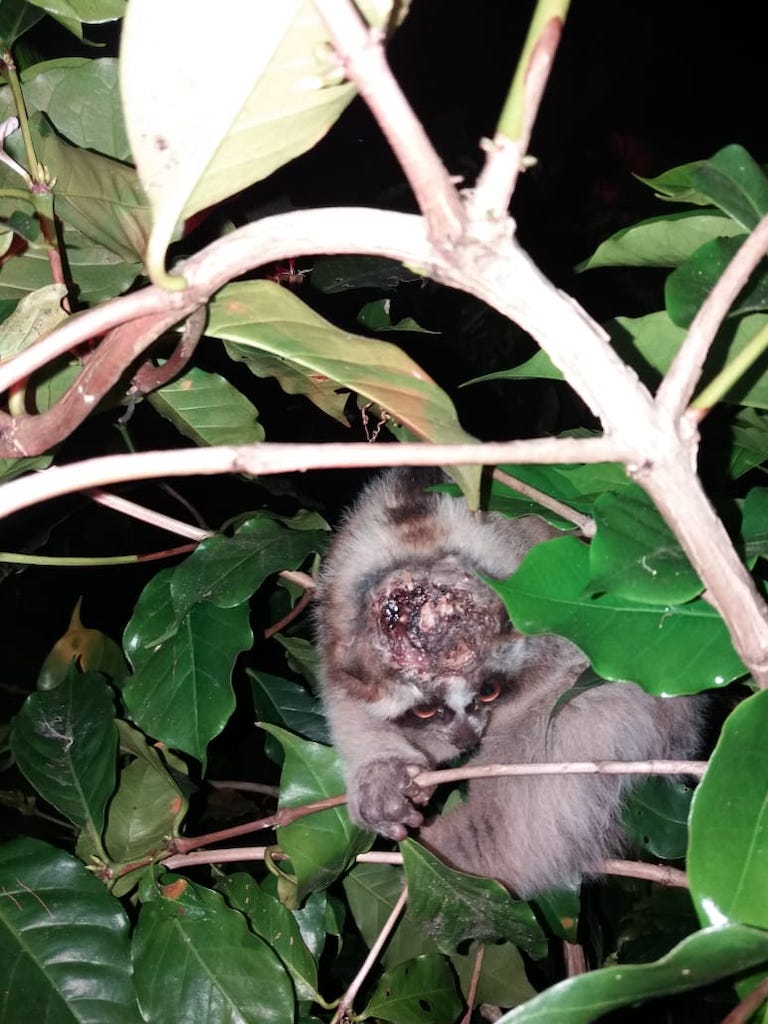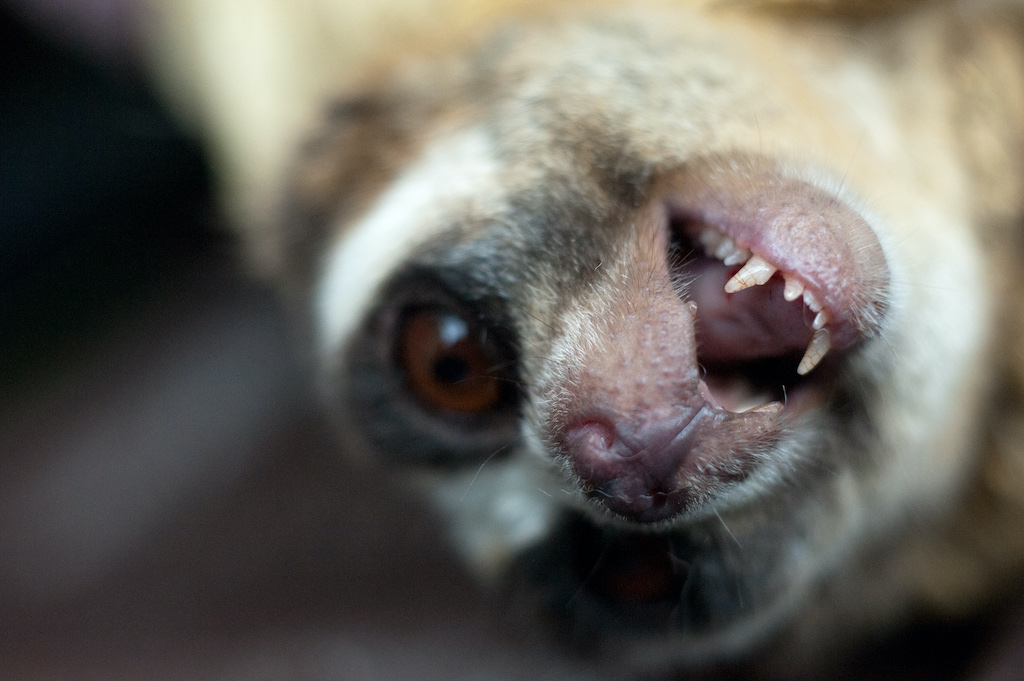- A study released Oct. 19 in the journal Current Biology reveals that slow lorises use their venom not only against other species, but also against each other — a behavior that is extremely rare among animals.
- Over eight years and hundreds of capture events, 20% of all Javan lorises surveyed had fresh wounds from other lorises. Both males and females having and using weapons within the same species is also rare.
- Although it is illegal to capture, sell or own lorises in all of their range countries, they are still caught for their use in traditional Asian medicine and for the pet trade.
- The trade of lorises involves pulling their teeth and subjecting them to situations that violate animal welfare criteria. Lorises lead rich and complex lives in the forest and because they are primates, isolation from their kin can be psychologically distressing. Also, they can kill you.

Videos and images of slow lorises being “tickled” have gone viral: their large eyes peering out, tiny arms raised overhead. But, as it turns out, the loris isn’t tickled to be there. It wants to kill.
Slow lorises raise their arms overhead both as a defensive posture and to gain quick licking access to oil glands near their armpits. In these glands is a potent cocktail of chemicals that, when mixed with their saliva, creates a powerful venom.
A study released Oct. 19 in the journal Current Biology reveals that Javan slow lorises (Nycticebus javanicus) use this venom not only against other species (such as humans), but also against each other.
The use of venom within individuals of the same species, known as intraspecific competition, is extremely rare, found in only five other species of animals.

“This new study is without doubt the biggest field-based study of the competitive use of venom in any species done to date,” Ronald Jenner, venom expert at the Natural History Museum in London told Mongabay. “It provides the most comprehensive evidence to date about how both male and female slow lorises use their venomous bites in competition for limited resources, such as territory or mates.”
Over a period of eight years, Anna Nekaris, a professor at Oxford Brookes University, U.K., along with colleagues from the University of Queensland, Australian, and Gadjah Mada University, Indonesia, captured, measured and placed radio collars on 82 Javan slow lorises within a field site in Java, Indonesia.
After climbing up a tree to catch a loris, the team would measure its size, rank it on a “fierceness scale,” and characterize its armpit secretions on a continuum from crusty to oozy. They also recorded any wounds.


Over eight years and hundreds of capture events, 20% of all the lorises had fresh wounds inflicted by other lorises. Nearly one-third of females and 57% of all males had signs of at least one venomous bite wound.
“So, it’s males and females,” said Nekaris, the lead author of the new study. “And if you look at weapon use within a species, across animals, it’s pretty rare for both males and females to have weapons and to use them.”
“This is in interesting contrast to another venomous mammal that uses venom intraspecifically, namely the duck-billed platypus,” said Jenner, who was not involved in the study. “But it is only male platypuses that are venomous, and they are thought to mostly use it on each other.”
Lorises’ teeth have grooves that allow the venom mixture in their mouths to move upward, like a wicking mechanism. And they also bite very, very hard — hard enough to pierce both bark and bone. These deep venomous bites can cause necrosis, decaying flesh, and leaving behind very nasty wounds.
One intrepid wildlife biologist was bitten by a slow loris and documented his harrowing recovery for science. Nekaris and colleagues have also surveyed zookeepers and rescue center workers, and, she said, “there were plenty of them who had had anaphylactic shock, blood in their urine, couldn’t even go into a room with a loris.”

But why are they biting each other? First, lorises are extremely territorial. The males protect their mates and the females their food and offspring. Females typically stay within and fiercely defend their range.
They also bite because of gum. Not chewing gum, but tree gum. Slow lorises tap into trees to eat the sappy resin from within. This is an excellent source of food for them, which means they guard their tree territories fiercely. And it may be their specialized gum-digesting saliva that also has allowed them to develop their potent venom, Nekaris said.
There are currently nine known species of lorises, all listed as either vulnerable, endangered or critically endangered on the IUCN Red List, and all listed on CITES Appendix I, which prohibits international trade of the species. The Javan slow loris is critically endangered, threatened both by the illegal pet trade as well as habitat loss.
Although it is illegal to capture, sell or own lorises in all of their range countries, they are still caught for their use in traditional Asian medicine and for the pet trade.
Lorises are notoriously “terrible pets” primatologist Sharon McCabe told Mongabay’s Jeremy Hance in a 2017 interview. They emit a strong odor, are sensitive to light, and can cause serious harm to the owner.
“Primates just shouldn’t be pets,” McCabe said. “They’re never going to be psychologically fulfilled as a pet; they’re never going to be healthy.”

“Trade of this animal often involves pulling out their teeth to avoid bites during handling, meaning these animals lose their ability to feed and defend themselves,” Muhammad Ali Imron from Gadjah Mada University and a co-author of the study, said in a statement. Some lories don’t survive the teeth-pulling operation. Those that do survive capture, transport and surgery go on to be very reluctant pets.
In the 2016 study “Is tickling torture?” Nekaris and her colleagues at Oxford Brookes University used an animal welfare scale to assess whether owning a loris as a pet violates any of the Animal Humane Society’s five freedoms of animal welfare criteria: freedom from hunger, disease, discomfort, distress, and the ability to carry out normal behaviors. Examining 100 popular videos on social media, her team found that all contained at least one animal welfare violation.

Lorises lead rich and complex lives in the forest, and because they are primates, isolation from their kin can be psychologically distressing. In the wild, the lorises live in family units where both parents and the older siblings care for the young, who spend as much as three years at home.
The Javan lorises also seem to fall in “love,” or at least form very strong bonds, and females can be choosy about their mates. Along with these amorous connections and choosy females come some dramatic and complicated behaviors, which, Nekaris says, can be helpful to understand though a soap opera analogy.
Take, for instance, that case of the middle-aged female loris Tereh, whose young lover was murdered by the loris Fernando.

Tereh, age ten, was living happily with her young mate Alomah, who was around 4 years old. “They loved each other,” Nekaris said. “He would just look at her like, ‘I love you.’ And they had four kids together and were so cute with the kids.”
Another male, Fernando, lost his mate to natural causes and set out looking for another. On his quest, he found Tereh. His desire was such that he killed her lover in a brutal battle. Tereh, heartbroken, wanted nothing to do with him. Her response was effectively, “You killed my love. Get out,” Nekaris says.
In other nocturnal primates, like night monkeys, the invading male can kill and take over the female very rapidly. But in lorises, female choice is strong, and they can defend themselves. Females may fight with males, slapping them, biting them, or throwing them out of trees.
Only recently, two years later, has Tereh the lady loris finally settled in with a new male. “So, she’s lost two years of reproduction, which is really important for these guys,” Nekaris said, “because she didn’t fall in love with anyone else.” Lorises have been known to live up to 25 years in captivity, so losing two reproductive years is a significant sacrifice.

Researchers still have much to learn about the complex behavior, ecology, and genetics of these “adorable little furball of deaths” Nekaris says. To this end, she currently leads the Little Fireface Project, a research, conservation, education and outreach program whose main project is the study of slow lorises on the Indonesian island of Java.
This week marks the organization’s ninth year of celebrating Slow Loris Outreach Week, culminating with their first-ever free and publicly accessible virtual slow loris conference. The conference will showcase the work of seasoned and novice loris researchers, conservationists and experts from every loris range country.
Nekaris says she hopes the research and outreach that she and others are engaged in will reduce people’s desire to keep lorises as pets, and will help them in “interpreting the many online videos on social media showing lorises in poses that are aggressive and related to delivering venom that people mistakenly interpret as being cute.”
And her advice to people who still might want one of these endangered and dangerous animals as a pet: “Get a gerbil.”

Citation:
Nekaris, K. A. I., Campera, M., Nijman, V., Birot, H. Rode-Margono, E. J., Fry, B. G, … Imron, M. A. (2020). Slow lorises use venom as a weapon in intraspecific competition. Current Biology, 30(20), 1252-1253. doi: 10.1016/j.cub.2020.08.084
Banner image of an adult male loris showing its teeth by Andrew Walmsley courtesy of the Little Fireface Project.
Liz Kimbrough is a staff writer for Mongabay. Find her on Twitter@lizkimbrough_
FEEDBACK: Use this form to send a message to the author of this post. If you want to post a public comment, you can do that at the bottom of the page.